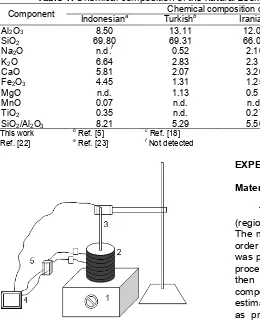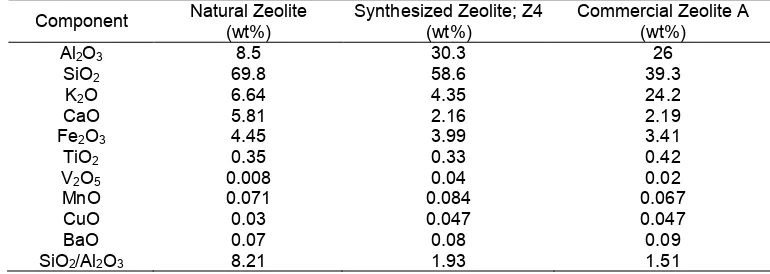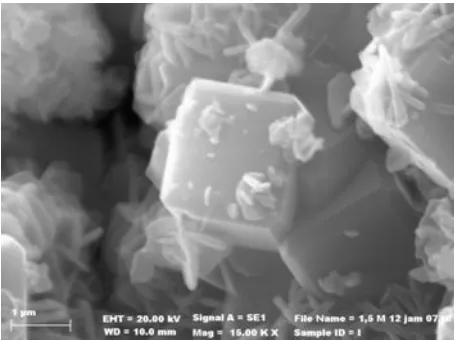SYNTHESIS OF ZEOLITE NaA FROM LOW GRADE (HIGH IMPURITIES) INDONESIAN
NATURAL ZEOLITE
Asalil Mustain, Gede Wibawa
*, Mukhammad Furoiddun Nais, and Miftakhul Falah
Department of Chemical Engineering, Faculty of Industrial Technology, Sepuluh Nopember Institute of Technology (ITS), Kampus ITS Sukolilo, Surabaya 60111, Indonesia
Received January 21, 2014; Accepted April 11, 2014
ABSTRACT
The zeolite NaA has been successfully synthesized from the low grade natural zeolite with high impurities. The synthesis method was started by mixing natural zeolite powder with NH4Cl aqueous solution in the reactor as
pretreatment. The use of pretreatment was to reduce the impurities contents in the zeolite. The process was followed by alkaline fusion hydrothermal treatment to modify the framework structure of natural zeolite and reduce the SiO2/Al2O3 ratio. Finally, the synthesized zeolite was calcined at 600 °C for 2 h. The final zeolite product was
characterized by X-ray fluorescence (XRF), X-ray diffraction (XRD) and scanning electron microscopy (SEM). The results showed that the morphology of the zeolite NaA was cubic shape as observed by SEM analysis and the synthesized zeolite NaA with pretreatment gave less impurity than without pretreatment.
Keywords:natural zeolite; zeolite NaA; synthesis; alkaline fusion; hydrothermal
ABSTRAK
Zeolit NaA telah berhasil disintesis dari zeolit alam kualitas rendah yang memiliki kandungan pengotor tinggi. Metode sintesis dimulai dengan mencampur serbuk zeolit alam dengan larutan NH4Cl dalam reaktor sebagai
perlakuan awal. Kegunaan dari perlakuan awal ini adalah untuk menurunkan kandungan pengotor dalam zeolit. Proses dilanjutkan dengan perlakuan hidrotermal fusi alkali untuk memodifikasi struktur rangka dari zeolit alam dan menurunkan rasio SiO2/Al2O3. Akhirnya, zeolit tersintesis dikalsinasi pada 600 °C selama 2 jam. Produk zeolit akhir
dikarakterisasi dengan X-ray fluorescence (XRF), X-ray diffraction (XRD) dan scanning electron microscopy (SEM). Hasil menunjukkan bahwa morfologi dari zeolit NaA adalah bentuk kubus seperti hasil observasi analisa SEM dan zeolit NaA tersintesis dengan perlakuan awal mempunyai pengotor yang lebih rendah daripada tanpa perlakuan awal.
Kata Kunci:zeolit alam; zeolit NaA; sintesis; fusi alkali; hidrotermal
INTRODUCTION
Indonesia has large potential reserves of natural zeolites because it lies within the ring of fire. At present, the zeolitic minerals in Indonesia, which have a potential deposit more than 400 million tons, have been explored. Clinoptilolite is the most abundant natural zeolite mainly found in a volcanogenic sedimentary rock [1]. Iron oxide, calcium oxide and quartz are usually present as impurities in the natural zeolite [2]. The specific impurities in the Indonesian zeolites are highly calcium oxide (CaO) contents. The presence of impurities caused the pore clogging and covered the active sides of the natural zeolite surface [3]. These impurities should be removed to enhance the performance before it was utilized in the chemical process.
Zeolites were divided into two categories: natural and synthesized groups. In the last decade, zeolites have been gaining great attention and proved very
useful in a wide range of applications. The natural zeolites were commonly used to remove heavy metal in water [4] and wastewater [5-6] treatment. Mostly, the synthesized zeolites were more valuable than the natural one. The uses of synthesized zeolites were particularly suitable as adsorbents in the alcohol purification [7-9] and esterification process [10-12]. The unique property of synthesized zeolite leads scientist to work in other possible area like as drug delivery systems in medical [13-16]. These possibilities allow zeolites to be material with great potential for many important applications.
Table 1.Chemical composition of the natural zeolite in this study and another region Chemical composition of natural zeolite (wt%)
Component
Indonesiana Turkishb Iranianc Chileand Chinesee
Al2O3 8.50 13.11 12.01 13.00 9.89
SiO2 69.80 69.31 66.03 67.00 65.52
Na2O n.d.f 0.52 2.10 2.60 2.31
K2O 6.64 2.83 2.31 0.45 0.88
CaO 5.81 2.07 3.20 3.20 3.17
Fe2O3 4.45 1.31 1.25 2.00 1.04
MgO n.d. 1.13 0.51 0.69 0.61
MnO 0.07 n.d. n.d. 0.04 0.06
TiO2 0.35 n.d. 0.27 0.20 0.21
SiO2/Al2O3 8.21 5.29 5.50 5.15 6.62
a
This work bRef. [5] cRef. [18]
dRef. [22] eRef. [23] fNot detected
Fig 1. Schematic diagram of apparatus: (1) magnetic stirrer; (2) reactor equipped with electric heater; (3) thermocouple; (4) thermo control; (5) electric contactor
sulfate or sodium aluminate as Al source. In order to find a simple and fast method, Kazemian et al. [18] developed a synthesis of submicron zeolite LTA particles from natural clinoptilolite and industrial grade chemicals using one stage procedure. Since natural zeolite has a specific impurities depend on the mining location, the treatment of activation requires some modification based on the condition of the natural zeolite resources. Taffarel and Rubio [19] treated Chilean zeolites by chemical method using some solution and activation with NH4Cl at room temperature caused a decrease in CaO, MgO and K2O composition.
The impurities contained in the synthesized zeolites and homogeneous product remained a problem to be overcome in the synthesis process. The aim of this study was to develop a synthesis method of low-grade natural zeolite with high impurities to produce synthesized zeolites NaA via alkaline fusion hydrothermal method. The effect of pretreatment and characterization of the product was also discussed as well.
EXPERIMENTAL SECTION
Materials
The low grade natural zeolite from Bandung (region of Indonesia) was used in the present study. The material was firstly washed with distilled water in order to remove all the soluble impurities. The sample was pulverized by using crusher, followed by screening process to give the particle size of 80-140 mesh and then dried in the oven at 110 °C. The chemical composition of the natural zeolite sample was estimated by using X-ray fluorescence (XRF) technique as presented in Table 1 together with the chemical composition of natural zeolite from another region as comparison. The results present that the impurities of Indonesian natural zeolite is higher than the comparing regions with the main impurities is CaO (5.81 wt%). Meanwhile, the CaO content of commercial zeolite A is only about 2 wt%. Ammonium chloride (NH4Cl), sodium hydroxide (NaOH) and sodium aluminates (NaAlO2) used in this study were produced by domestic company with industrial grade materials. NH4Cl aqueous solution from 1 to 2 mol·L-1 and NaOH aqueous solution 2 mol·L-1were prepared with distilled water.
Instrumentation
The apparatus used in this study consists of 100 ml reactor equipped with stirrer, heater, and thermocouple. The temperature of the reactor was controlled by using thermo control (Transmitt G-7) with accuracy of ± 1 °C. The schematic diagram of the apparatus was shown in Fig. 1.
The chemical compositions of the samples were carried out by X-ray fluorescence (XRF) using PANalytical PW 4030 Spectrometer. X-ray Diffraction (XRD) patterns were obtained by using Philips X'Pert MPD diffractometer. The powder patterns were taken in
Table 2.The effect of pretreatment on the final product of the synthesis process
1Clinoptilolite 2Mordenite 3Zeolit NaA
Table 3.Chemical composition of the natural zeolite, synthesized zeolite (Z4) and commercial zeolite A by mean of XRF
Al2O3 8.5 30.3 26
SiO2 69.8 58.6 39.3
K2O 6.64 4.35 24.2
CaO 5.81 2.16 2.19
Fe2O3 4.45 3.99 3.41
TiO2 0.35 0.33 0.42
V2O5 0.008 0.04 0.02
MnO 0.071 0.084 0.067
CuO 0.03 0.047 0.047
BaO 0.07 0.08 0.09
SiO2/Al2O3 8.21 1.93 1.51
was used with the tube operated at 40 kV and 30 mA. PANalytical X'Pert HighScore software was used to confirm the crystallinity phase of the samples from the powder patterns. The particle morphology of the synthesized zeolites were investigated by scanning electron microscopy (SEM) analysis, performed by using Carl Zeiss EVO MA10 instrument. To avoid surface charging, samples were coated with gold under vacuum prior to analysis.
Procedure
The process was started by mixing 5 g of natural zeolite powder with 100 ml of NH4Cl aqueous solution from 1 to 2 mol·L-1 and stirred from 12 to 20 h in the reactor at room temperature as pretreatment. Pretreatment was intended to reduce the impurities contents in the natural zeolite. The resulting material was filtered and dried at 110 °C for 10 h. The process was followed by alkaline fusion hydrothermal treatment to modify the framework structure of natural zeolite. The process was carried out by mixing the preceding material with 90 mL of NaOH aqueous solution 2 mol·L-1 and 6.13 g (stoichiometric calculation) of sodium aluminates under magnetic stirring in the reactor at
80 °C for 8 h. The final synthesis solution was filtered, washed with distilled water and then dried in the oven at 110 °C for 10 h. Finally, the product was calcined in the furnace at 600 °C for 2 h to remove the occluded organics from inside the zeolite pore space.
RESULT AND DISCUSSION
The chemical composition and the cristallinity phase of each sample by means of XRF and XRD analysis are given in Table 2. The results show that the CaO content in the synthesized zeolite significantly decreased after the synthesis process. The SiO2/Al2O3 ratio can also be reduced in the range of 1.7-2 and zeolite NaA is the predominant crystallinity phase in the sample product. Due to the SiO2/Al2O3 ratio of several samples of zeolite NaA are in the range of 1.4-2.2, the SiO2/Al2O3 ratio of the natural zeolites in this work (=8.21, as shown in Table 2) must be reduced by adding appropriate amounts of sodium aluminate in the alkaline medium provided by sodium hydroxide as mineralizing agent. The synthesis process of zeolite NaA from natural zeolite in this study based on the following mechanisms [18],
2 2 4
Fig 2.Experimental XRD pattern: (a) natural zeolite and
(b) synthesized zeolite NaA Fig 3.SEM image of the natural zeolite
Fig 4.SEM image of the synthesized zeolite NaA
6 26 230 2 4 12 212 212 2
2 NaAlO SiO · H O + 48 NaAl OHn 5 Na AlO SiO · H Om (2)
The best product obtained from this process was sample Z4 because of natural zeolite with SiO2/Al2O3 ratio of 8.21 was converted to zeolite NaA with SiO2/Al2O3 ratio of 1.93 and CaO impurities might also be reduced from 5.81 wt% to 2.16 wt% by the addition of 1.5 mol·L-1 NH4Cl and agitation time of 12 h.
Alkaline fusion hydrothermal treatment without the addition of NH4Cl, which in this case is sample Z0, shows that CaO contents in this product remain high as in the natural zeolite. In the synthesis process with or without the addition of NH4Cl, zeolite NaA can be produced. However, the product of the process without the addition of NH4Cl still contains high CaO impurities. The developed pretreatment in this study is advantageous because the SiO2/Al2O3 ratio is still around 2 (low ratio) and it doesn’t change the framework structure of the zeolite products with alkaline fusion hydrothermal treatment. Moreover, it is also able to reduce the CaO impurities [19].
The chemical composition of the natural zeolite, synthesized zeolite (Z4) and commercial zeolite A are presented together in Table 3. In these results, the Al2O3 content of the synthesized zeolite significantly increased to 30.3 wt% in comparison to the parent natural zeolite (i.e. 8.5 wt%) due to the addition of sodium aluminates in the synthesis process. These results are revealed that the synthesized zeolite (Z4) has similar compositions with the commercial zeolite A. The differences are only in the observed K2O, SiO2, and Al2O3 contents, but the value of SiO2/Al2O3 ratio is quite similar. In addition, the main components of zeolite, which are SiO2 and Al2O3 contents, in the synthesized zeolite NaA are higher than the commercial one. From a chemical composition point of view, the developed process in this study is advantage as the total amount of SiO2and Al2O3in the product are approximately 88.9 wt%.
The XRD measured pattern of the raw natural zeolite is shown in Fig. 2a. According to this result, clinoptilolite (2= 9.83°, 22.37°, 26.05°, 28.17°, 30.00°, 32.01°) and mordenite (2 = 9.76°, 22.21°, 25.58°, 27.68°) phases were observed. Fig. 2b shows the experimental pattern of the synthesized zeolite (Z4) and it clearly presents that the product of the synthesized zeolite in this study belongs to zeolite NaA (2 = 7.18°, 10.16°, 21.65°, 23.97°, 27.09°, 29.92°, 34.16°) as indicated by the position of the peak patterns. The crystallographic parameters of the zeolite NaA are the cubic crystal system and the space group Fm3c with the lattice parameters a = b = c = 24.61 Å and=== 90° [20].
average size of approximately 5 m, forms the narrow size distribution particles with an average size of approximately 2 m after the synthesis process. SEM image of the synthesized zeolite NaA shows the cubic morphology of the material, which agrees with the previous literature data [21].
CONCLUSION
The developed pretreatment for alkaline fusion hydrothermal method was successfully reduced the impurities content in the synthesized zeolite. From this process, high impurities natural zeolite with SiO2/Al2O3 ratio of 8.21 was capable to be converted to zeolite NaA with SiO2/Al2O3 ratio of 1.93 and less CaO impurities (2.16 wt%). SEM result shows that the average particle size of the product was approximately 2 m. From a chemical composition point of view, the developed process in this study was advantage due to the high SiO2and Al2O3contents in the product.
ACKNOWLEDGEMENT
This research was supported by research grant of Sepuluh Nopember Institute of Technology (ITS) under Contract No: 0750.253/I2.7/PM/2011.
REFERENCES
1. Wang, S., and Peng, Y., 2010, Chem. Eng. J., 156 (1), 11–24.
2. Boukadir, D., Bettahar, N., and Derriche, Z., 2002, Ann. Chim. Sci. Mat., 27 (4), 1–13.
3. Athanasiadis, K., and Helmreich, B., 2005, Water Res., 39 (8), 1527–1532.
4. Doula, M.K., 2006,Water Res., 40 (17), 3167-3176. 5. Erdem, E., Karapinar, N., and Donat, R., 2004, J.
Colloid Interface Sci., 280 (2), 309–314.
6. Faghihian, H., Marageh, M.G., and Kazemian, H., 1999,Appl. Radiat. Isot., 50 (4), 655–660.
7. Caro, J., Noack, M., and Kölsch, P., 2005, Adsorption, 11 (3-4), 215–227.
8. Kondo, M., Yamamura, T., Yukitake, T., Matsuo, Y., Kita, H., and Okamoto, K., 2003, Sep. Purif. Technol., 32 (1-3), 191–198.
9. Morigami, Y., Kondo, M., Abe, J., Kita, H., and Okamoto, K., 2001,Sep. Purif. Technol., 25 (1-3), 251–260.
10. Ameri, E., Moheb, A., and Roodpeyma, S., 2010, Chem. Eng. J., 162 (1), 355–363.
11. de la Iglesia, Ó., Mallada, R., Menéndez, M., and Coronas, J., 2007, Chem. Eng. J., 131 (1-3), 35– 39.
12. Li, W., Liu, W., Xing, W., and Xu, N., 2013, Ind. Eng. Chem. Res., 52 (19), 6336–6342.
13. Amorim, R., Vilaça, N., Martinho, O., Reis, R.M., Sardo, M., Rocha, J., Fonseca, A.M., Baltazar, F., and Neves, I.C., 2012,J. Phys. Chem. C, 116 (48), 25642–25650.
14. Braschi, I., Gatti, G., Paul, G., Gessa, C.E., Cossi, M., and Marchese, L., 2010, Langmuir, 26 (12), 9524–9532.
15. Braschi, I., Blasioli, S., Gigli, L., Gessa, C.E., Alberti, A., and Martucci, A., 2010, J. Hazard. Mater., 178 (1-3), 218–225.
16. Martucci, A., Pasti, L., Marchetti, N., Cavazzini, A., Dondi, F., and Alberti, A., 2012, Microporous Mesoporous Mater., 148 (1), 174–183.
17. Kamali, M., Vaezifar, S., Kolahduzan, H., Malekpour, A., and Abdi, M.R., 2009, Powder Technol., 189 (1), 52–56.
18. Kazemian, H., Modarress, H., Kazemi, M., and Farhadi, F., 2009, Powder Technol., 196 (1), 22–25.
19. Taffarel, S.R., and Rubio, J., 2009, Miner. Eng., 22 (4), 336–343.
20. Gramlich, V., and Meier, W.M., 1971,Z. Kristallogr. Kristallgeom. Kristallphys. Kristallchem., 133 (1), 134–149.
21. Loiola, A.R., Andrade, J.C.R.A., Sasaki, J.M., and da Silva, L.R.D., 2012,J. Colloid Interface Sci., 367 (1), 34–39.
22. Englert, A.H., and Rubio, J., 2005, Int. J. Miner. Process., 75 (1-2), 21–29.


